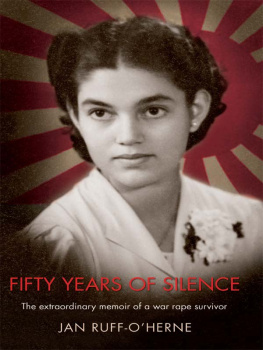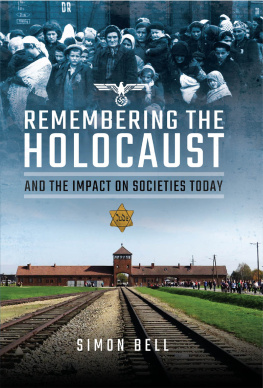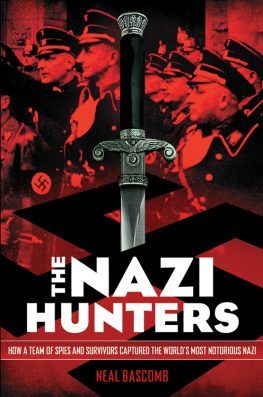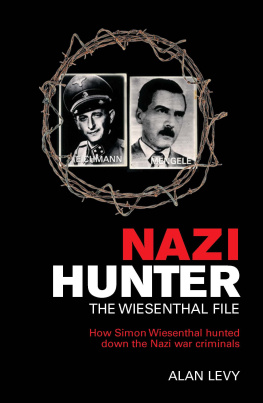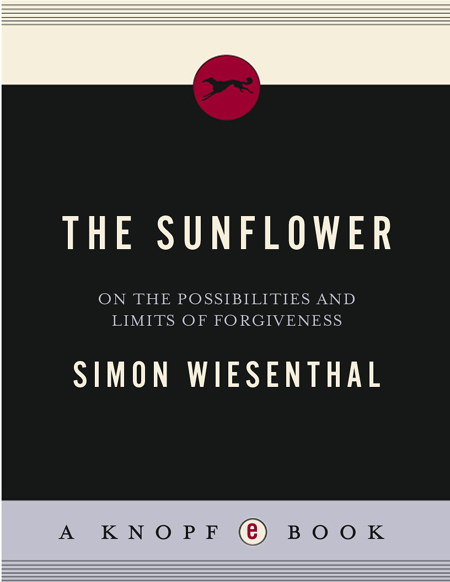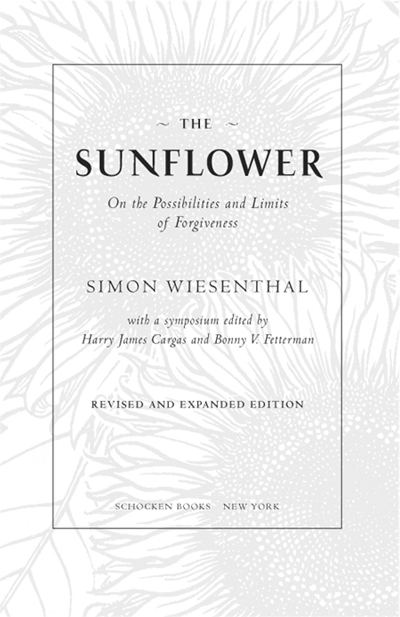PREFACE
When the first American edition of The Sunflower was published by Schocken Books in 1976, courses about the Holocaust had just begun to appear in the curricula of colleges, high schools, and seminaries. Because it's a book that invites discussion, The Sunflower soon became one of the most widely used books in teaching settings. Simon Wiesenthal tells a personal story of an incident that occurred in a concentration camp and asks, what would you have done in his place? Theologians, political and moral leaders, and writers responded to his questiona question that is at once religious, political, moral, and personaleach from their own perspective. As would be expected, a wide variety of opinions was expressed. Nevertheless, each and every respondent had to imagine him or herself in the place of a concentration camp prisoner, to face the enormity of the crime before them, and reflect on the implications of their decision. In this one isolated case, was forgiveness an option, and what would it mean for the victim as well as the perpetrator of these crimes?
The twentieth anniversary of its publication in this country is the occasion for a new edition of The Sunflower. This second edition presents thirty-two new responses written for this volume, ten retained from the previous edition, and one, by Edward H. Flannery, revised for this edition. Three contributionsby Jean Amry, Cardinal Knig, and Albert Speerwere translated from the 1981 German edition and appear here for the first time in English translation.
Why a new edition of The Sunflower? In light of the events of the last twenty years, we felt it would be interesting to hear the responses of a new generation. On the one hand, time blunts memory; on the other, our knowledge and awareness of the Holocaust has increased through education. Even those who do not have a living memory of the Holocaust have begun to assimilate what it means for a people to lose one-third of its members to genocide, together with their culture, language, and history. The uniqueness of this event has finally started to sink in to the popular consciousness. Moreover, we suspected that the major changes in the Catholic church's teachings about Jews in these years, as well as other interfaith events and developments, would produce responses that differed from the first generation of respondents. Finally, the world has not stopped seeing horrors that approach genocidein Bosnia, Cambodia, China, and countless other troubled nations around the globeas whole classes of people are targeted for extinction by criminal regimes. The issue posed by Simon Wiesenthal in this book is still with us, transcending its original context, and forcing itself upon a contemporary one.
Few people would deny the necessity of bringing criminal leaders and policymakers to justice. Wiesenthal's Dokumentationszentrum, which seeks out Nazi criminals, has helped to bring over 1,100 Nazis to justice since the end of the war. For his work, Wiesenthal has been honored by the governments of the United States, Holland, Italy, and Israel. Committed to the necessity of enforcing international law, Wiesenthal wrote to President Clinton in July of 1995, urging him to condemn the organizers of terror in the former Yugoslavia: The events in Bosnia, as the media portray them for us today, with all their crimes against humanitythe ethnic cleansing, the slaughtering of civilians regardless of age, the rape of Muslim womenwhile they do not constitute a Holocaust, repeat many of its horrors.I believe that the condemnation of Karadzic and Mladicverbal, at firstand the threat to put them before a tribunalwould have an effect. The United States could, I hope, put an end to the deeds of these two men and their soldiers by publicly announcing that the crimes they committed will not remain unpunished. The importance to the world of holding such individuals responsible for their crimes is indisputable.
But the question posed in The Sunflower is more subtle and, in some sense, more vexing. What about the rank-and-file, the faceless individuals who carry out the crimes against other people ordered by their leaders? What about the individual responsibility of ordinary people, blinded or coerced by the reigning political ideology of their day, and of the small number who may regret their actions or repudiate them in a different climate? We laud the heroic individuals who defy and undermine the immoral actions of their governments, despite the mortal dangers such resistance entailsbut what of the converse?
Moreover, when the killing has stopped, how can a people make peace with another who moments before were their mortal enemies? What are the limits of forgiveness, and is repentancereligious or secularenough? Is it possible to forgive and not forget? How can victims come to peace with their past, and hold on to their own humanity and morals in the process?
All of these issues are raised in this simple and unpretentious book of questioning, based on a single and exceptional encounter between two individuals whose paths strangely and tragically crossed.
BONNY V. FETTERMAN
October 1996
PREFACE TO THE PAPERBACK EDITION
The revised and expanded edition of The Sunflower sparked a new round of public forums and symposia in high schools, colleges, seminaries, and educational institutions across the country. This first paperback edition of the revised and expanded Sunflower includes additional responses by Rebecca Goldstein, Mary Gordon, Susannah Heschel, Jos Hobday, Matthieu Ricard, Sidney Shachnow, and Desmond Tutu.
March 1998
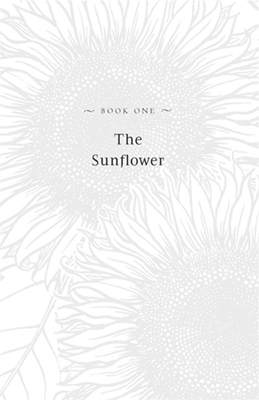
W hat was it Arthur said last night? I tried hard to remember. I knew it was very important. If only I were not so tired!
I was standing on the parade ground, where the prisoners were slowly assembling. They had just had their breakfasta dark, bitter brew which the camp cooks had the nerve to call coffee. The men were still swallowing the stuff as they mustered for the roll call, anxious not to be late.
I had not fetched my coffee as I did not want to force my way through the crowd. The space in front of the kitchen was a favorite hunting-ground for the many sadists among the SS. They usually hid behind the huts and whenever they felt like it they swooped like birds of prey on to the helpless prisoners. Every day some were injured; it was part of the program.
As we stood around silent and gloomy waiting for the order to fall in my thoughts were not concerned with the dangers which always lurked on such occasions, but were entirely centered on last night's talk.
Yes, now I remembered!
It was late at night. We lay in the dark; there were low groans, soft whispering, and an occasional ghostly creak as someone moved on his plank bed. One could hardly discern faces but could easily identify a speaker by his voice. During the day two of the men from our hut had actually been in the Ghetto. The guard officer had given them his permission. An irrational whim? Perhaps inspired by some bribe? I did not know. The likelihood was that it was a mere whim, for what did a prisoner possess to bribe an officer with?
And now the men were making their report.



